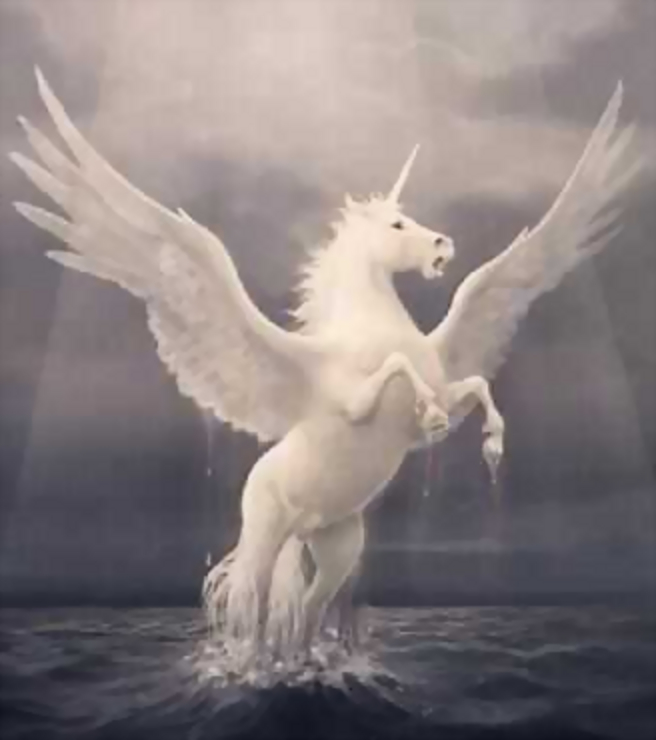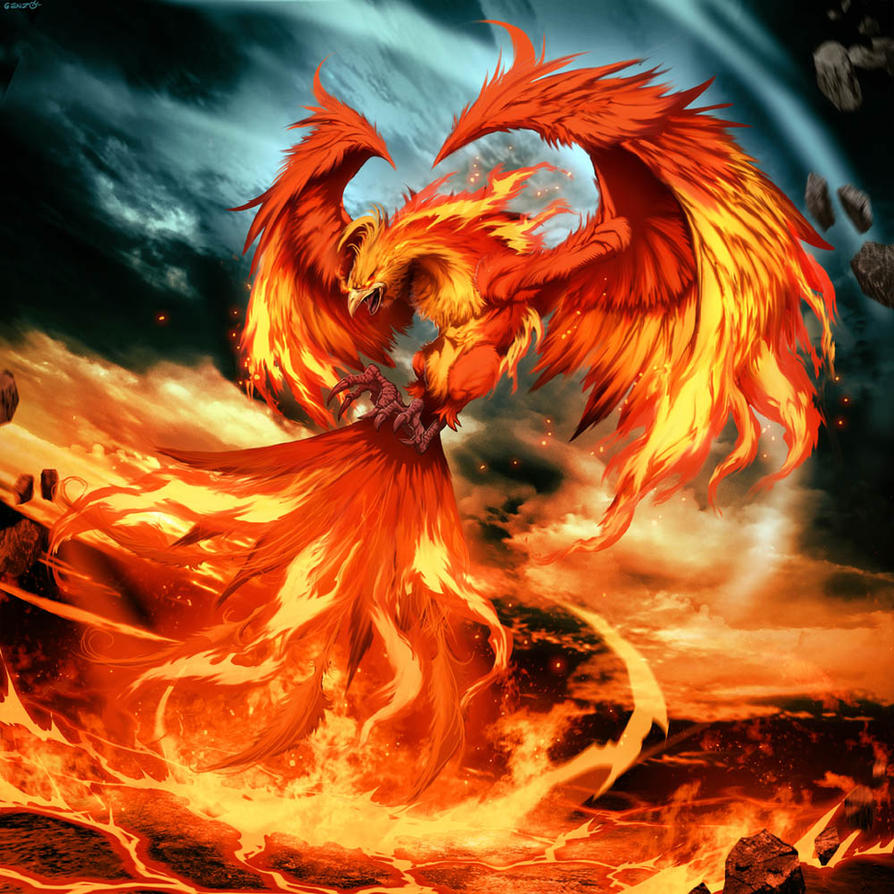Raijū (雷獣,"thunder animal" or "thunder beast") is a legendary creature from Japanese mythology. Its body is composed of lightning and may be in the shape of a cat, fox, weasel, or wolf. The form of a white and blue wolf (or even a wolf wrapped in lightning) is also common. It may also fly about as a ball of lightning (in fact, the creature may be an attempt to explain the phenomenon of lightning). Its cry sounds like thunder.
About
Tuesday, 11 September 2012
Dullahan
Dullahan is headless, usually seen riding a black horse and carrying his or her head under one arm. The head's eyes are massive and constantly dart about like flies, while the mouth is constantly in a hideous grin that touches both sides of the head. The flesh of the head is said to have the color and consistency of moldy cheese. The dullahan's whip is actually a human corpse's spine, and the wagons they sometimes use are made of similarly funereal objects (e.g. candles in skulls to light the way, the spokes of the wheels made from thigh bones, the wagon's covering made from a worm-chewn pall). When the dullahan stops riding, it is where a person is due to die. The dullahan calls out their name, at which point they immediately perish.
Salamender
The salamander is an amphibian of the order Urodela. As with many real creatures, pre-modern authors often ascribed fantastic qualities to it (compare the allegorical descriptions of animals in medieval bestiaries), and in recent times some have come to identify alegendary salamander as a distinct concept from the real organism. This idea is most highly developed in the occult. Where the two concepts can be distinguished, the legendary salamander is most often depicted much like a typical salamander in shape, with alizard-like form, but it is usually ascribed an affinity with fire (sometimes specifically elemental fire).
Goblin
They are attributed with various (sometimes conflicting) abilities, temperaments and appearances depending on the story and country of origin. In some cases, goblins have been classified as constantly annoying little creatures somewhat related to the brownie andgnome. They are usually depicted as small, sometimes only a few inches tall, sometimes the size of a dwarf. They also often are said to possess various magical abilities.
Dwaft
In Germanic mythology, a dwarf (Old English dweorg, Old Norse dvergr, Old High German zwerc and gitwerc) is a being that dwells in mountains and in the earth, and is associated with wisdom, smithing, mining, and crafting. Dwarfs are also sometimes described as short and ugly, although some scholars have questioned whether this is a later development stemming from comical portrayals of the beings.
Skeleton
A skeleton is a type of physically manifested undead often found in fantasy, gothic and horror fiction, and mythical art. Most arehuman skeletons, but they can also be from any creature or race found on Earth or in the fantasy world.
Kitsune
Kitsune (狐?, IPA: [kitsɯne] ( listen)) is the Japanese word for fox. Foxes are a common subject of Japanese folklore; in English,kitsune refers to them in this context. Stories depict them as intelligent beings and as possessing magical abilities that increase with their age and wisdom. Foremost among these is the ability to assume human form. While some folktales speak of kitsune employing this ability to trick others—as foxes in folklore often do—other stories portray them as faithful guardians, friends, lovers, and wives.
listen)) is the Japanese word for fox. Foxes are a common subject of Japanese folklore; in English,kitsune refers to them in this context. Stories depict them as intelligent beings and as possessing magical abilities that increase with their age and wisdom. Foremost among these is the ability to assume human form. While some folktales speak of kitsune employing this ability to trick others—as foxes in folklore often do—other stories portray them as faithful guardians, friends, lovers, and wives.
Berserker
Berserkers (or berserks) were Norse warriors who are reported in the Old Norse literature to have fought in a nearly uncontrollable, trance-like fury, a characteristic which later gave rise to the English word berserk. Berserkers are attested to in numerous Old Norse sources. Most historians believe that berserkers worked themselves into a rage before battle, but some think that they might have consumed drugged foods.
Chimera
Oni
Oni (鬼?) are creatures from Japanese folklore, variously translated as demons, devils, ogres or trolls. They are popular characters in Japanese art, literature andtheatre.[1]
Depictions of oni vary widely but usually portray them as hideous, gigantic ogre-like creatures with sharp claws, wild hair, and two long horns growing from their heads.[2] They are humanoid for the most part, but occasionally, they are shown with unnatural features such as odd numbers of eyes or extra fingers and toes.[3] Their skin may be any number of colors, but red and blue are particularly common.
Tengu
Tengu (天狗?, "heavenly dogs") are a class of supernatural creatures found in Japanese folklore, art, theater, and literature. They are one of the best known yōkai (monster-spirits) and are sometimes worshipped as Shinto kami (revered spirits or gods). Although they take their name from a dog-like Chinese demon (Tiangou), the tengu were originally thought to take the forms of birds of prey, and they are traditionally depicted with both human and avian characteristics. The earliest tengu were pictured with beaks, but this feature has often been humanized as an unnaturally long nose, which today is widely considered the tengu's defining characteristic in the popular imagination.
Inugami
Inugami In Japanese mythology an inugami ("dog god") resembling, and usually originating from, a dog, (although other similar species are interpreted as being. eg, Wolves, Raccoons, and Weasels.) and most commonly carrying out vengeance or acting as guardians on behalf of their "inugami owner". Inugami are extremely powerful and capable of existing independently, (without master or possession) as well as turning on their "owners" and even possessing humans. Even so, while Inugami can betray their masters, they may also be the loyalest of companions
Pegasus
Pegasus (Ancient Greek: Πήγασος, Pégasos, Latin Pegasus) is one of the best known mythological creatures in Greek mythology. He is a winged divine horse, usually depicted as white in colour. He was sired by Poseidon, in his role as horse-god, and foaled by the Gorgon Medusa.[1] He was the brother of Chrysaor, born at a single birthing when his mother was decapitated by Perseus.
Tuesday, 4 September 2012
Kraken
Kraken are legendary sea monsters of giant proportions said to dwell off the coasts of Norway andGreenland.
The legend may actually have originated from sightings of real giant squid that are variously estimated to grow to 13–15 m (40–50 ft) in length, including the tentacles.[2][3] These creatures normally live at great depths, but have been sighted at the surface and have reportedly attacked ships.
Hydra
In Greek mythology, the Hydra (Ancient Greek: Ὕδρα) was an ancient nameless serpent-like chthonic water beast, with reptilian traits, (as its name evinces) that possessed many heads — the poets mention more heads than the vase-painters could paint, and for each head cut off it grew two more — and poisonous breath so virulent even her tracks were deadly.[1] The Hydra of Lerna was killed by Heracles as the second of his Twelve Labours. Its lair was the lake of Lerna in the Argolid, though archaeology has borne out the myth that the sacred site was older even than the Mycenaean city of Argos since Lerna was the site of the myth of theDanaids. Beneath the waters was an entrance to the Underworld, and the Hydra was its guardian
Griffin
The griffin, griffon, or gryphon (Greek: γρύφων, grýphōn, or γρύπων, grýpōn, early form γρύψ, grýps; Latin: gryphus) is a legendary creature with the body of a lion and the head and wings of an eagle. As the lion was traditionally considered the king of the beasts and the eagle was the king of the birds, the griffin was thought to be an especially powerful and majestic creature. The griffin was also thought of as king of the creatures. Griffins are known for guarding treasure and priceless possessions.
Unicorn
The unicorn is a legendary animal from European folklore that resembles a white horse with a large, pointed, spiraling horn projecting from its forehead, and sometimes a goat's beard and cloven hooves. First mentioned by the ancient Greeks, it became the most important imaginary animal of the Middle Ages and Renaissance when it was commonly described as an extremely wild woodlandcreature, a symbol of purity and grace, which could only be captured by a virgin.
Cerberus
Cerberus is a creature with three-headed which guards the gates of the Underworld, to prevent those who have crossed the river Styx from ever escaping. Cerberus featured in many works of ancient Greek and Roman literature and in works of both ancient and modern art and architecture, although the depiction and background surrounding Cerberus often differed across various works by different authors of the era.
Dragon
A dragon is a legendary creature, typically with serpentine or reptilian traits, that features in the myths of many cultures. There are two distinct cultural traditions of dragons: the European dragon, derived from European folk traditions and which is ultimately related to Greek and Middle Eastern mythologies, and the Chinese dragon, with counterparts in Japan, Korea and other East Asian countries.
Phoenix
It is a bird with a colorful plumage and a tail of gold and scarlet (or purple, blue, and green according to some legends). It has a 500 to 1000 year life-cycle, near the end of which it builds itself a nest of twigs that then ignites; both nest and bird burn fiercely and are reduced to ashes, from which a new, young phoenix or phoenix egg arises, reborn anew to live again.
Subscribe to:
Posts (Atom)




















